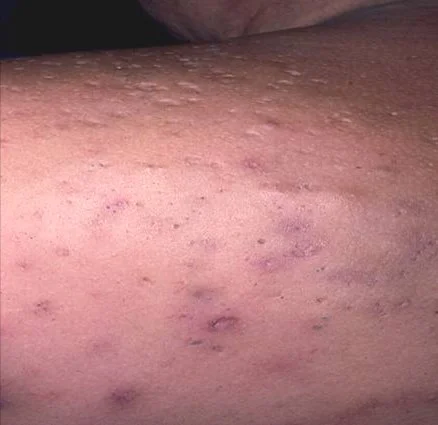Treatment of Acne vulgaris
Treatment: Basic Principles
- Systemic and topical retinoids, systemic and topical antimicrobials, and systemic hormonal therapies are the main classes of treatment
- Multiple agents are often used with activity against different pathogenic causes (e.g. topical antibiotic plus retinoid)
- Use topical antibiotics with benzoyl peroxide to prevent the development of antibiotic resistance
- Acne scarring is difficult to treat, therefore aggressive prevention is important
Acne Scarring
-
Acne should be treated aggressively to avoid permanent scarring and cysts
-
Refer patients with difficult to control acne or the presence of scarring to dermatology

Common First-Line Treatments
-
Mild comedonal: topical retinoid, +/- topical benzoyl peroxide
-
Mild papular/pustular: topical retinoid, topical antibiotics (clindamycin, erythromycin), topical benzoyl peroxide
-
Moderate papular/pustular: oral antibiotics with topical retinoid and benzoyl peroxide
-
Moderate nodular without scarring: oral antibiotic with topical retinoid and topical benzoyl peroxide
-
Severe nodular: refer to a dermatologist for oral isotretinoin
-
Scarring and keloids: refer to a dermatologist for oral isotretinoin
Topical Retinoids
(tretinoin, all trans retinoic acid)
-
Topical retinoids are vitamin A derivatives
-
Used for acne vulgaris; photodamaged skin; fine wrinkles, hyperpigmentation
-
Patients should be warned of common adverse effects:
- Dryness, pruritus, erythema, scaling
- Photosensitivity
-
Available as a cream or gel
-
Do not apply at the same time as benzoyl peroxide because benzoyl peroxide oxidizes tretinoin
Benzoyl Peroxide
-
Benzoyl peroxide is a topical medication with both antibacterial and comedolytic properties
-
Available as a prescription and over-the-counter, as well as in combinations with topical antibiotics
-
Patients should be warned of common adverse effects:
- Bleaching of hair, colored fabric, or carpet
- May irritate skin; discontinue if severe
-
Available as a cream, lotion, gel, or wash
Topical Antibiotics
-
Used to reduce the number of P. acnes and reduce inflammation in inflammatory acne
-
Do not use as monotherapy (often used with benzoyl peroxide to prevent the development of antibiotic resistance in the treatment of mild-to-moderate acne and rosacea)
- Erythromycin 2% (solution, gel)
- Clindamycin 1% (lotion, solution, gel, foam)
-
Metronidazole 0.75%, 1% (cream, gel) is used in the treatment of rosacea
Topical Acne Treatment: Side Effects
-
Topical acne treatments are often irritating and can cause dry skin
- When using retinoids or benzoyl peroxide, consider beginning on alternate days. Use a moisturizer to reduce their irritancy.
-
Topical agents take 2-3 months to see effect
-
Patients will often stop their topical treatment too early from “red, flakey” skin without improvement in their acne
-
Patient education is a crucial component to acne treatment
Oral Antibiotics
-
Tetracycline, doxycycline, minocycline
-
Use for moderate to severe inflammatory acne
-
Often combined with benzoyl peroxide to prevent antibiotic resistance
-
If the patient has not responded after 3 months of therapy with an oral antibiotic, consider:
- Increasing the dose,
- Changing the treatment, or
- Referring to a dermatologist
Oral Isotretinoin
-
Oral isotretinoin, a retinoic acid derivative, is indicated in severe, nodulocystic acne failing other therapies
-
Should be prescribed by physicians with experience using this medication
-
Typically given in a single 5-6 month course
-
Isotretinoin is teratogenic and therefore absolutely contraindicated in pregnancy
- Female patients must be enrolled in a FDA-mandated prescribing program in order to use this medication
- Two forms of contraception must be used during isotretinoin therapy and for one month after treatment has ended
Isotretinoin: Side Effects
-
Common side effects of isotretinoin include:
- Xerosis (dry skin)
- Cheilitis (chapped lips)
- Elevated liver enzymes
- Hypertriglyceridemia
-
Individuals with severe acne may suffer mood changes and depression and should be monitored
-
Severe headache can be a manifestation of the uncommon side effect pseudotumor cerebri
Patient Education
-
Patient education and setting expectations are important components of effective acne treatment
- Lack of adherence is the most common cause of treatment failure
- With the patient, the physician should develop the therapeutic regimen with the highest likelihood of adherence
- Acne treatment is only treating new lesions, not the ones already there
-
Patients should use only the prescribed medications and avoid potentially drying over-the-counter products, such as astringent, harsh cleansers or antibacterial soaps
- Recommend daily moisturizer when patients are using solutions and gels because they have more drying effects than creams and ointments
-
Overaggressive washing and the use of particulate abrasive scrubs often exacerbates acne and should be avoided
-
Cosmetics are often labeled as “non-comedogenic” or “oil-free” if they do not cause or exacerbate acne